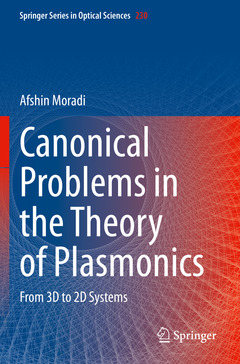Canonical Problems in the Theory of Plasmonics, 1st ed. 2020 From 3D to 2D Systems Springer Series in Optical Sciences Series, Vol. 230
Auteur : Moradi Afshin

Part I: Three-Dimensional Electron Gases.- Chapter 1: Basic concepts and formalism. Chapter 2: Problems in Electrostatic Approximation.- Chapter 3: Problems in Electromagnetic Theory.- Chapter 4: Problems in Electrostatic Approximation: Spatial Nonlocal Effects.- Chapter 5: Problems in Electromagnetic Theory: Spatial Nonlocal Effects.- Part II: Two-Dimensional Electron Gases.- Chapter 6: Electrostatic Problems Involving Two-Dimensional Electron Gases in Planar Geometry.- Chapter 7: Electromagnetic Problems Involving Two-Dimensional Electron Gases in Planar Geometry.- Chapter 8: Electrostatic Problems involving Two-Dimensional Electron Gases in Cylindrical Geometry.- Chapter 9: Electromagnetic Problems Involving Two-Dimensional Electron Gases in Cylindrical Geometry.- Chapter 10: Boundary-Value Problems Involving Two-Dimensional Electron Gases in Spherical Geometry.
Date de parution : 05-2021
Ouvrage de 349 p.
15.5x23.5 cm
Date de parution : 05-2020
Ouvrage de 349 p.
15.5x23.5 cm



